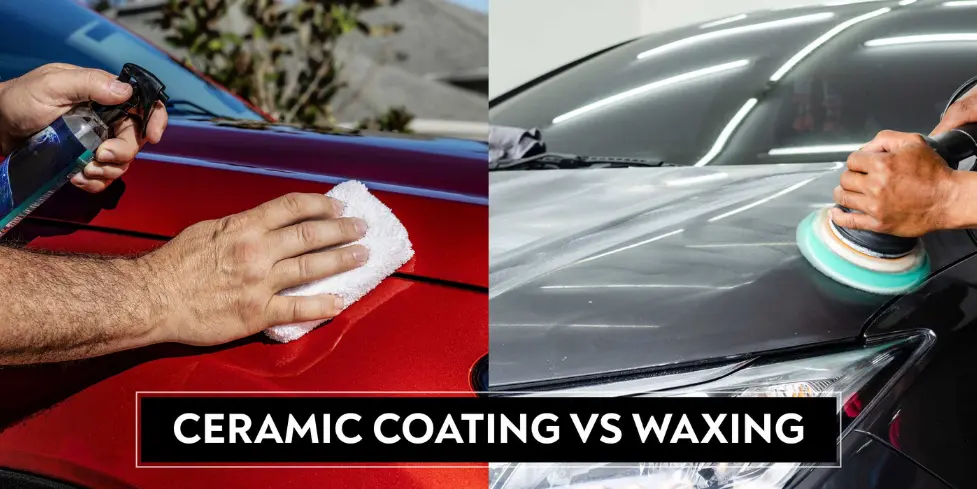Ceramic Coating or Wax!? a question that car owners and detailers ask when thinking of protecting and maintaining car’s paintwork aesthetic and increasing its visual appeal. Each one has unique benefits and drawbacks, and might by deferent car owners based on their preference and lifestyle. This comparison will help you choose which option will work best with your vehicle! For more info about ceramic coating service visit our service page devoted exclusively to that topic!
What Is Wax?
Wax is becoming a popular car paint protectant that is made of both synthetic and natural components that are typically found in carnauba wax synthetic wax liquid wax, Spray wax types. Wax adds the appearance of gloss on its surfaces and also protects against environmental contaminants, providing a protection shield.
Types of Wax
| Type of Wax | Description |
|---|---|
| Carnauba Wax | Derived from the leaves of the Carnauba palm, this natural wax provides a deep, rich shine and good protection. |
| Synthetic Wax | Made from synthetic polymers, this type of wax offers longer-lasting protection and easier application compared to natural waxes. |
| Liquid Wax | Easier to apply than paste wax, liquid wax is suitable for quick applications but may not last as long. |
| Spray Wax | The quickest and easiest to apply, but it provides the shortest duration of protection and shine. |
| Paste Wax | Offers the best protection and shine among waxes but requires more effort to apply and buff. |
| Hybrid Wax | Combines natural and synthetic waxes for enhanced durability and a deep, glossy finish. |
Pros of Wax:
- Cost-Effective: Wax is generally less costly than ceramic coatings and easier to apply than them by hand or machine, making DIY enthusiasts’ work much simpler.
- Aesthetic Enhancement: It gives your car’s paint color depth while simultaneously offering rich glossy shine enhancing aesthetic appeal.
Cons of Wax
- Short-Term Protection: Wax often needs reapplying every few months as its protective properties diminish quickly.
- Less Durable: Wax provides only limited UV ray protection, scratches protection and chemical contamination defense against chemical contaminants in the environment.
- Maintenance: Regular wax applications and maintenance sessions will keep a car’s finish looking pristine.
What Is Ceramic Coating?
Ceramic coating is a liquid polymer which chemically bonds to vehicle paintwork to form an ultra-protective and semi-permanent/permanent layer, usually consisting of SiO2 ceramic particles for maximum resilience against environmental hazards and extreme weather.
Types of Ceramic Coating
| Type of Ceramic Coating | Description |
|---|---|
| Silica-Based Coatings | Popular for their high durability and protection, these coatings are known for their hardness and resilience. |
| Graphene Coatings | Leveraging advanced graphene technology, these coatings provide excellent heat resilience, durability, and enhanced hydrophobic properties. |
| Titanium Dioxide Coatings | Known for their exceptional UV protection and self-cleaning properties. |
| Hybrid Coatings | Blending different materials, these coatings combine various properties, mainly durability, water repellency, and gloss enhancement. |
| Ceramic Nanocoatings | These coatings harness nanotechnology to create a thin, protective layer that bonds with the car’s surface, providing excellent durability and contaminant resistance. |
| SiO2 (Silicon Dioxide) Coatings | Known for their durability and water-repellent properties, these coatings provide a strong protective layer. |
Read this article to know the comprehensive benefits of ceramic coatings.
Pros of Ceramic Coating
Long-Lasting Protection: Ceramic coatings provide long-term protection of two to five years or longer depending on quality and maintenance practices, depending on quality standards. They also offer superior resistance against UV rays, oxidation, bird droppings, tree sap, and other potential threats such as contaminants in the air or spilled beverages from cars passing closeby.
- Hydrophobic Properties: Ceramic coatings create water-repellant surfaces, making cleaning your car much simpler.
- Enhance Gloss: They give off an intense reflective shine that outlives wax’s temporary glossiness.
- Ceramic coatings offer more scratch resistance compared to wax applications;
- Their initial costs tend to be more costly as well. Waxes do not last as long. Ultimately, ceramics may offer greater scratch and swirl mark protection,
Cons of Ceramic Coating
-
- Costs way more than waxing.
- Professional Application Recommended: In order to achieve optimal results, professional installation may often be required.
- Not Completely Scratchproof: Even though ceramic coatings provide enhanced protection, they still can become scratched or damaged over time.
Detailed Comparison: Ceramic Coating vs Wax
Durability and Longevity
| Aspect | Ceramic Coating | Wax |
|---|---|---|
| Durability | 2-5 years or more | A few months |
| Reapplication | Infrequent, depends on quality | Every 3-6 months |
Protection Against Environmental Hazards
| Hazard | Ceramic Coating | Wax |
|---|---|---|
| UV Rays | Excellent | Moderate |
| Chemical Contaminants | Excellent | Limited |
| Bird Droppings | Excellent | Limited |
| Tree Sap | Excellent | Limited |
| Oxidation | Excellent | Limited |
| Minor Scratches | Good | Limited |
Maintenance
| Aspect | Ceramic Coating | Wax |
|---|---|---|
| Ease of Cleaning | High | Moderate |
| Frequency of Application | Low | High |
Cost
| Aspect | Ceramic Coating | Wax |
|---|---|---|
| Initial Cost | High | Low |
| Long-Term Cost | Potentially Lower | Higher due to frequent reapplications |
Aesthetic Impact
| Aspect | Ceramic Coating | Wax |
|---|---|---|
| Gloss and Shine | Long-lasting, deep, reflective finish | Short-term, requires frequent reapplication |
| Depth of Color | High | Moderate |
Decision Factors
When deciding between ceramic coating and wax, consider the following factors:
Budget
| Factor | Ceramic Coating | Wax |
|---|---|---|
| Initial Investment | Higher | Lower |
| Long-Term Costs | Potentially Lower | Higher due to ongoing maintenance |
Desired Level of Protection and Durability
| Factor | Ceramic Coating | Wax |
|---|---|---|
| UV Protection | Superior | Moderate |
| Chemical Resistance | Superior | Limited |
| Scratch Resistance | Good | Limited |
Maintenance and Application
| Factor | Ceramic Coating | Wax |
|---|---|---|
| Ease of Application | Requires professional application for best results | Easy to apply, DIY-friendly |
| Maintenance Effort | Low | High |
Common Questions
What is the difference between Ceramic Coating & Wax?
The ceramic coating can be described as a polymer that’s liquid that chemically bonds with your car’s paintwork, providing longer-term (2-5 years) protection as well as protection against environmental hazards. Wax is, however serves as an interim measure of protection that needs frequent application, it only provides some basic protection.
How often should I apply wax to my car?
Wax should typically be reapplied every 3-6 months depending on environmental conditions and the type of wax used.
Can I apply ceramic coating myself?
As DIY ceramic coating kits may provide acceptable results, professional application may produce better outcomes. Proper surface preparation and careful application will guarantee optimal performance and improve results.
Does ceramic coating protect my car against scratches and scrapes?
Ceramic coating offers excellent scratch protection but may not prevent all scratch marks entirely. But ceramic can offer superior defense against minor scrapes and swirl marks than wax can.
Are ceramic coatings worth their costs and investments?
Ceramic coating should be considered an investment when seeking long-term protection, superior durability, and reduced maintenance requirements. Over time it could even prove more cost effective than frequently applying wax.
How does hydrophobic coating benefit car maintenance?
Ceramic coating’s hydrophobic nature causes water and contaminants to roll off its surface easily, making car cleaning much simpler while decreasing frequency of washes.
What are the drawbacks associated with ceramic coating?
Ceramic coating has several drawbacks that must be considered when considering it for application – initial cost and professional application being the two primary ones. While it provides good protection, scratches or damages still occur.
Check out Ceramic Coating Myths, Conspiracy Theories and Myths
Also Check Best Ceramic Coating Kits in 2024
Conclusion
Deciding between ceramic coating and wax depends entirely upon your unique needs and preferences. For long-lasting protection with reduced maintenance needs and gloss enhancement benefits, ceramic coating offers outstanding environmental defense while adding lasting gloss enhancement. Alternatively, wax is more cost-effective and easy to apply compared to its counterpart; wax may provide less frequent but costlier maintenance services – perfect if frequent maintenance visits are part of the plan!
Ceramic coating and wax both serve a place in car care, so when making your decision it’s important to factor your budget, desired level of protection, time commitment to maintenance as well as any associated advantages/disadvantages before making your selection. By understanding both options fully you’ll make an informed choice that fits both your vehicle and lifestyle needs.



